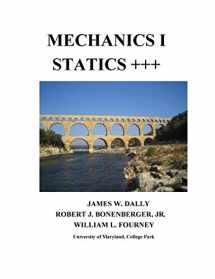
Mechanics I Statics+++
ISBN-13:
9781935673293
ISBN-10:
1935673297
Edition:
4th ed.
Author:
James W Dally, Robert J Bonenberger, William L Fourney
Publication date:
2016
Publisher:
College House Enterprises, LLC
Format:
Paperback
366 pages
FREE US shipping
Book details
ISBN-13:
9781935673293
ISBN-10:
1935673297
Edition:
4th ed.
Author:
James W Dally, Robert J Bonenberger, William L Fourney
Publication date:
2016
Publisher:
College House Enterprises, LLC
Format:
Paperback
366 pages
Summary
Mechanics I Statics+++ (ISBN-13: 9781935673293 and ISBN-10: 1935673297), written by authors
James W Dally, Robert J Bonenberger, William L Fourney, was published by College House Enterprises, LLC in 2016.
With an overall rating of 3.5 stars, it's a notable title among other
Mechanics
(Physics) books. You can easily purchase or rent Mechanics I Statics+++ (Paperback) from BooksRun,
along with many other new and used
Mechanics
books
and textbooks.
And, if you're looking to sell your copy, our current buyback offer is $0.3.
Description
The content of the Mechanics I textbook includes methods for determining stresses and strains in uniaxial members, column buckling loads, and a discussion of material properties and material behavior. Because we have included three topics not normally found in traditional Statics books, we have added the three plus signs to the subtitle Statics +++. We introduced the concept of stresses in uniaxial members, because an analysis of the forces in some structural element is incomplete. Determining the force is not sufficient to establish the safety of the structural member or to design its cross section. However, it is easy to introduce stresses in uniaxial members s = P/A, and we have taken this important step toward a more complete analysis. Next, we added a chapter on materials and material properties introducing yield and ultimate tensile strength. Determining the stress and comparing this value with the strength of an engineering material enables the student to establish the safety factor or the margin of safety of the structural element. We have found that extending the analysis to incorporate safety and/or design improves the student’s interest and motivation. We often include a project that involves student teams building a model of a truss, which is subsequently tested in the laboratory. The students perform a truss analysis and predict the failure load of their model. In testing the models, we found that compression members on many of the trusses failed at loads much lower than the values predicted by the student teams. These compression members were buckling at relatively low loads, while the stresses were lower than the strength of the model material. This laboratory experience enabled us to discuss elastic instability and to demonstrate buckling. We have added a chapter on Euler (elastic) buckling to this edition to enable the student to study and to begin to understand elastic instability in structures.


We would LOVE it if you could help us and other readers by reviewing the book
Book review

Congratulations! We have received your book review.
{user}
{createdAt}
by {truncated_author}


